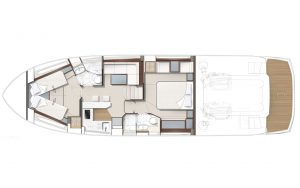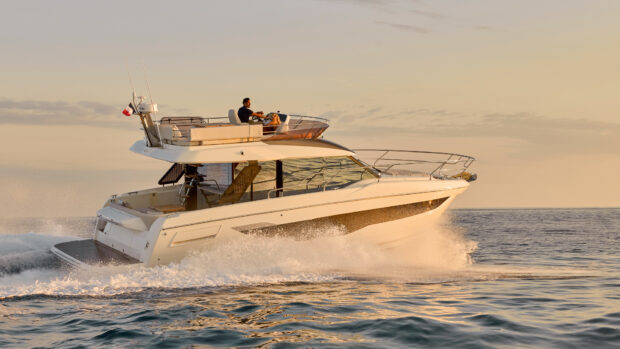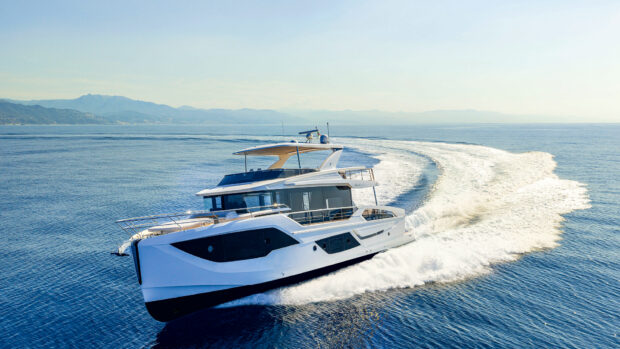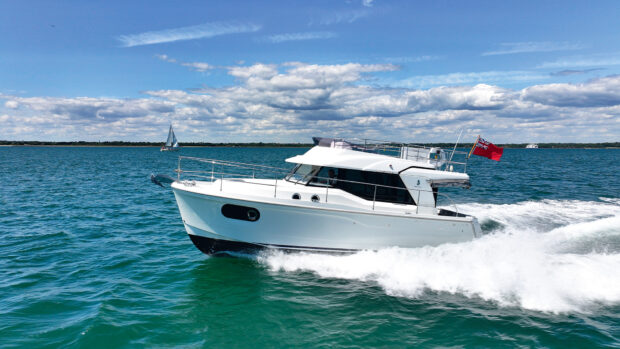The latest addition to the Predator range boasts a voluminous interior and versatile main deck but is it still worthy of the Predator moniker?
In 2013 the high-end 50ft sports cruiser market went into hyperdrive. Sunseeker launched the San Remo at the London Boat Show in the January. It looked fantastic, with sleek styling and an optional open-backed hardtop over the main deck cockpit area. The inside was a stylish and beautifully wrought cocoon of quality, complete with full beam master cabin. But there was no getting away from the fact that it was just a convincing update of Sunseeker’s Portofino 48, something that larger hull windows and neat interior detailing didn’t entirely disguise.
When Princess launched its new-from-the-keel-up V48 later that same year, although the basic layout was similar, it did highlight some of the San Remo’s shortcomings, most notably the lack of full standing headroom throughout that full-beam master cabin. Princess also introduced the concept of a deck saloon version as well as a more traditional open-backed hard top (cunningly launching the open in Cannes and the deck saloon version almost simultaneously at the Southampton Boat Show).
It was a formula that Fairline mirrored with its Targa 48, also available in Open and ‘GT’ (deck saloon) versions, plus a Squadron 48 flybridge variant. All had IPS600 and all were two-cabin with the option of swapping the lower dinette for a third twin-bunked bedroom. Similarly priced once you matched the specifications, the trio fought head-to-head for sales.

The Sunseeker Predator 50 has a sporty top speed of 32 knots
For 2018, Princess has updated the V48 to create the V50, ironically in much the same way that Sunseeker had updated the 48 Portofino, by creating larger hull windows and upscaling the interior finish.
But this year it’s Sunseeker’s turn to pull the wraps off a new from-the-keel-up model. The San Remo is dead, long live the Predator 50.
On paper the concept is broadly similar, a hard top sportscruiser sporting the classic Sunseeker curve to the sheerline accentuated by the stainless steel rubbing band, and the equally classic blocky Sunseeker script at the aft end of the boot top line. The only slightly jarring note is the way that the rubbing band changes direction when it reaches the engine vents.
Get up close and personal and you realise that this is a really tall boat, side decks at eye level when you’re stood on the pontoon. Large triple section hull windows closely mirror the rest of the Predator range, as does the profile of the hard top. Step aboard and you’ll discover that Sunseeker has combined that extra height with a couple of extra feet in the length and 8in more in the beam to banish the word compromise for ever.

The aft-facing bench makes the cockpit more sociable
Life on deck
It’s not the hull windows or the hardtop profile that earn this boat its Predator moniker, it’s the fact that it has a proper deck saloon whereas the San Remo was all cockpit on the main deck. But unlike Fairline’s Targa 48 or Princess’s V50, you don’t lose the tender garage as a result – there’s still space for a Williams 325 behind the transom.
You get the sunpad on top too, albeit split by a folding backrest that allows you to choose between forward facing cockpit seating or lying full length. A very pleasant touch is an aft facing seat ahead of it; so many boat cockpits only allow you to sit facing the saloon doors, leaving the view behind you. It’s a neat layout and it keeps the cockpit short, maximising the interior space.

Sunseeker Hawk 38 breaks cover
Designed in conjunction with legendary powerboat racer Fabio Buzzi, the Sunseeker Hawk 38 will do over 60 knots 'out of

Sunseeker 161 Yacht: Fast displacement hull form explained
Move into the saloon (linked or shut off from the cockpit by a top-hinged window and a conventionally opening, rather than sliding, glass door) and it feels massive, helped by enormous side windows. It’s no illusion either, as the interior length of the Predator 50 matches that of the Predator 57. Sunseeker is staying tight-lipped about volume comparisons – the Pred 57 is larger, but not by as much as you might think.

The glass doors slide out of the way to cleverly open the interior to the cockpit
The most obvious beneficiary of this additional length is the large C-shaped seating area around the table as well as a separate L-shaped raised settee next to the helm. Overhead, the one carry over (in appearance at least) from the San Remo is a large carbon fibre sliding roof section with inset glass panels so that it only shuts out the weather, not the light. Finish is typical Sunseeker; high quality satin cherry as standard, with silver oak or walnut in gloss or open grain satin at extra cost.

The VIP cabin berths slide together to make a double
Head downstairs and the layout is entirely familiar, a guest cabin forward with its scissor berths offering vee berth singles or a centreline double and ensuite access to the day heads. The space opposite the galley can be configured at build with either a dinette or a twin-bunk third cabin. The full-beam master cabin is aft. But while the basic setup might mirror the boat it replaces, the actual feeling is quite different.

The galley may be downstairs but it’s a very good size
It’s down here that you really feel the benefit of that increased height: the headroom in the galley is vast. But that extra space is also three dimensional; there’s masses of elbow room, enough to add a third leg to the galley in the form of a neat breakfast bar (although you’ll have to delve into the options list and pay extra for stools if you’d like to sit at it). And that master cabin now has full height headroom everywhere.

The master cabin’s dinette can be replaced with a settee or another chest of drawers
Okay, the floor might jig up and down a little more than the very shallow steps of the V48 floor, but your scalp is safe. The standard layout includes a small table with opposing seats under the starboard side window, but you can swap this for a settee or match the chest of drawers fitted to the port side for a small additional cost if you prefer (that last option isn’t a bad one because while storage is good, there’s nothing under the bed except diesel – the fuel tank lives there). Talking of additional cost, “sprung mattresses for all beds” is also on the options list, which feels a little mean in a £750,000 boat…
Drive time
So the Predator 50 is a ‘space ship’, all interior compromise banished. The (three quarters of a) million pound question is, has that compromise simply been shifted across to the driving experience? At the helm all seems normal, the 16in Volvo display offering virtual engine instrumentation as well as navigation (there’s space for a matching second screen) and the usual IPS joystick sited just behind the throttle levers.
But all is not as it seems – there are no pods poking out of the hull of this boat, instead you’ll find conventional shafts and rudders. That joystick (included with each of a range of package upgrades) links engine controls, rudders and a 12hp variable speed bow thruster to offer IPS-style manoeuvring and docking. Just like IPS, push the stick where you want to go and the boat responds. Twist it and the boat spins.

Traditional shafts are the only option on the 50, though there is an optional joystick
So why the change? With that extra height, length and beam comes extra weight and while the 435hp from each IPS600 unit was enough to push the San Remo past 30 knots, for the larger Predator 50 additional power was needed. Upgrading to more powerful IPS units would have pushed up the cost to the point where conventional shaft drives started to make more sense, so the engineers opted for vee drive shafts, allowing the engines to sit in much the same place as IPS drives and leaving space ahead of them for that generous full-beam master cabin.

Shaft drive spaces the engines wide apart, granting great access around both engines although the tender garage severely limits headroom
The first telltale is a cultured flair of revs on start up from the waterline height side exhausts. At low speed the boat is exceptionally quiet, and as the revs build the decibels barely rise. The bow does though, blocking sight lines as the Predator climbs on to the plane, enough to require half tabs and sitting on the raised seat bolster to maintain good vision.
In fairness, tall bow cushions in place for the photo shoot didn’t help – if you were going any distance you’d probably remove them. The windscreen is a long way ahead of the helm and the mullions are swept stylishly back, which blocks peripheral vision a little, although in practice it’s one of those things you notice when the boat is stationary but seem to work around unconsciously at speed.

The rotating Sunseeker logo always stays correctly orientated whatever position the steering wheel is in
The flat calm sea conditions weren’t very conducive to exploring the outer reaches of the new boat’s seakeeping ability, only the wash from 74 tonnes of Predator 74 photo boat at a frankly implausible 40 knots providing any kind of challenge. The Predator 50 thundered through the mountains of water streaming off the 74’s stern quarters with the slightly blunt feel of a boat tuned toward space rather than pace, but it’s hardly a fair test. In more normal cruising conditions the Predator 50 feels every bit as capable as you’d expect of a Sunseeker.
The steering is entirely electronic rather than hydraulic with no physical link to the rudders themselves. Nor is there a tie bar between the rudder posts, both move independently of each other, powered by individual electric motors, although a synchro box means full steering can be maintained should one motor fail.
With no requirement for physical leverage, the steering is super quick. Just over one turn whips the boat from the straight ahead to full lock, slightly over two turns cranking you hard over the other way, and it’s fingertip light. The Predator 50 banks enthusiastically in response, feeling every inch the sports boat, even though the shaft and rudder setup means the actual turning circle at speed is fairly broad. It’s still a fun steer though.

The U-shaped foredeck seating ensures there is space for deck hatches above the VIP cabin
Verdict
There’s no getting around the fact that the Predator 50 is nearly 20 tonnes of voluminous boat, not an agile slalom skier. It’s built for covering ground and it does that well, and most of all, quietly. At the helm it’s barely any louder at 20 knots than it is at tickover, and that raised seating area alongside means that the whole crew can gather and enjoy the journey. In fact, they’re better off here than in the cockpit, where inevitably it’s noisier with just a hint of a vortex effect that will eventually frost your sunglasses with a light dusting of salt spray.
So the new 50 is a bigger (and more expensive) boat than its predecessor and its competition, but does it live up to its Predator billing? The answer is an emphatic yes, provided you accept that the Predator moniker is more about sporty styling combined with world class luxury and refinement than searing pace, razor-sharp handling and offshore wave-jumping – these days it’s what the market demands. It is a genuinely good-looking boat, the shaft drive gives it more of a ‘big boat’ feel, and it retains enough driving dynamic to justify the ‘sport’ in sportscruiser.

Specifications
Top speed: 32 knots
Cruising speed: 20 knots
Fuel consumption: 167lph
Range: 172 miles
Noise: 70Db(A)
Price as tested: £979,790
Price from: £810,000 (inc. VAT)
Test engines: Twin 600hp Volvo Penta D8
LOA: 54ft 0in (16.48m)
Beam: 14ft 9in (4.48m)
Draught: 4ft 4in (1.33m)
Displacement: 19 tonnes
Fuel capacity: 1,800 litres
Water capacity: 430 litres
RCD Category: B for 12 people
Designer: Sunseeker International
Price as reviewed:
£979,790.00










